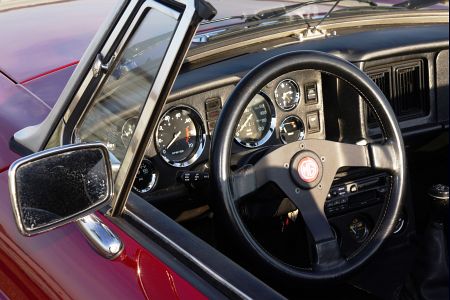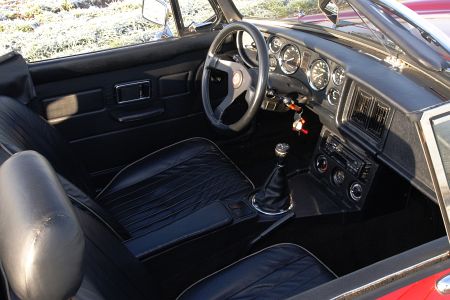1977 MGB Run-On
Peculiar to the 1977 MGBs (and some, very early 1978’s) is a wiring design fault that allows the engine to continue running when the key is turned off. This problem is quite distinct! When the key is turned off and even removed from the ignition key switch, the car continues to RUN – not diesel – but RUN! This normally continues for about 30 seconds, but on some MGBs can continue indefinitely! This problem is easily corrected.

At the introduction of the electric cooling fan (1977 model year) the factory added an “ignition relay” so that the current necessary to run the cooling fans would not have to pass through the key switch. The fans draw a great amount of current, and there was no point in redesigning the key switch to handle the current increase when a relay was so easily added.
So, when the key switch is turned from OFF, through ACCESSORY, to ON, the WHITE circuit goes hot. This WHITE circuit runs to three locations: the ignition warning light; the fuel pump (through the impact switch); and the ignition relay. When the key is ON, the warning light illuminates, the fuel pump begins ticking, and the ignition relay closes. In turn, with the ignition relay closed, power is supplied to: the bi-metal fan switch located at the top of the radiator; to the forward side of the fuse box (to the third fuse, the WHITE/GREEN fuse); AND to the ignition coil (through the ballast resistor, which is simply a five foot long piece of resistance wire – a shiny pinkish color). So, the ignition coil is powered from the ignition relay, NOT the key switch.
The engine ceases to operate not because of a lack of ignition, but because of a lack of fuel! When the key switch is turned from ON, through ACCESSORY, to OFF, the SLATE circuit is energized. When the key is OFF and there is OIL PRESSURE, then the anti run-on valve operates. This valve prohibits the free flow of fresh air into the charcoal adsorption canister. (In normal operation, the fresh air flows through the anti run-on valve, through the charcoal canister, into the top of the engine, then through the engine (collecting fumes and blowby), out of the front tappet inspection cover, and into the carburetor, then into the combustion chamber where it is burned. The charcoal adsorption canister is also connected to the carburetor float bowl and the gasoline tank vent.)
The effect of stopping the fresh air entering this Positive Crankcase Ventilation (PCV) System is to cause an evacuation of air within the engine and the charcoal canister. In addition to this “passive” evacuation, the anti run-on valve routes manifold vacuum into the charcoal canister. Now the vacuum within the canister becomes dramatic! This vacuum, in turn, is transferred to the carburetor float bowl. Since the carburetor mixes fuel with air based on the pressure differential between the float bowl pressure (atmospheric) and the venturi pressure (depressed), a vacuum in the float bowl prohibits the gasoline from mixing with the air and the engine STOPS DEAD.

If the original Stromberg carburetor is still fitted, and all the hoses in the PCV and Evaporative Loss Control (ELC) system are intact, then the engine stops quickly – as it should, with no dieseling. (Earlier cars pollute the atmosphere with unburned hydrocarbons (gasoline) when turned off, since the engine continues to turn AFTER the ignition is turned off.) If a replacement carb has been fitted (especially a WEBER), or if the hoses are broken or disconnected, then the engine can continue to run if the ignition relay remains closed.
When the ignition switch is turned from OFF to ON, and the WHITE circuit is energized, battery voltage passes to the IGNITION WARNING LIGHT, then down the BROWN/YELLOW wire to the alternator field diodes (the Indicator or IND terminal), and then to earth. The circuit complete, the ignition warning light illuminates. When the engine starts, voltage is produced by the field diodes and battery voltage begins to move out of the alternator, UP the BROWN/YELLOW wire to the ignition warning light. When the lamp receives battery voltage from both directions, it winks out.
Now we’re ready to explain why the engine continues to run! First, the anti run-on circuit is not working (hoses, wiring, or valve). When the key is turned off, the current from the alternator runs UP the BROWN/YELLOW, through the ignition warning light, and into the WHITE CIRCUIT. There is a very large voltage drop after passing through the ignition warning light, but there is still enough voltage to HOLD the ignition coil closed (it’s not enough to PULL it closed, but enough to HOLD is closed). So, voltage from the alternator holds the ignition relay closed – and the MGB continues to RUN!!
To eliminate this condition, simply fit a diode into the BROWN/YELLOW wire at the alternator, with the arrow in the diode pointed TOWARDS the alternator. Now the ignition warning light will work correctly, but the current cannot reverse direction and travel INTO the WHITE circuit. You can purchase small diodes at Radio Shack, or you can salvage one from under the glovebox (GREEN/ORANGE wires which work the handbrake warning light).
The wiring was changed early in the 1978 model year so that the ignition coil is powered directly from the key switch!


